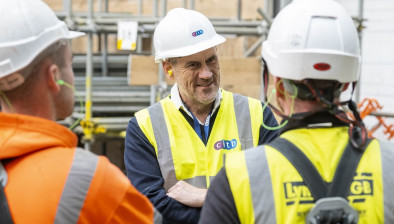Ian Hughes: The Skills Investment Plan and guiding partner investment in skills
Meeting the current and future skills needs of employers was the focus of the first Skills Investment Plan for Scotland’s Construction Sector, published four years ago.
In the latest in a series of articles highlighting work resulting from the Skills Investment Plan, Ian Hughes, director of CITB Scotland, explains the role the plan has played in guiding partner investment in skills.

Ian Hughes
Evidence and research lies at the centre of the work we do at the CITB, helping us to identify the priorities for the sector and to set strategic direction.
That’s why the Skills Investment Plan for Scotland’s construction sector is such an important collaboration, bringing us together with Skills Development Scotland and many other agencies in the public and private sector with a stake in Scotland’s construction industry.
We can use the plan’s evidence base to prioritise which interventions or areas of activity are required, either occupationally or geographically, and the real benefit is that all parties buy into it and hold each other to account to make sure that we deliver against what the research is telling us.
CITB Scotland wants to continue the year-on-year rise in the number of apprenticeships in construction. More than a quarter of all Modern Apprentices are in the sector so it’s still the profession of choice among many young people, and we want to work with partners across the public and private sectors to continue that trend and expand the use of Foundation and Graduate Apprenticeships which are central to the industry’s future.
At the same time there are other priority areas such as the skills needs of rural Scotland. For the next three years we have ring-fenced investment to address challenges in areas such as the South of Scotland and the Highlands and islands, targeting occupations such as supervisors, estimators and bricklayers where there are the greatest number of opportunities.
In this way, we see a lot of our efforts as aligned to the wider needs of the construction sector and the economy, so rather than being project-specific it’s part of a wider strategic approach, and that needs to involve the public and private sectors working closely and collectively in order to maximise their investment.
Neither CITB Scotland nor any of its partners, can solve these challenges in isolation. We have to continue working closely together to identify who’s best at doing what and then making progress.
Ultimately, such skills requirements really are based on market demand, so as construction methodologies and construction companies evolve and innovate, the skills of the workforce have to keep up. We are keen that we invest in the right targeted areas that will have maximum benefit for the entire Industry and the companies within it.
That’s why we are investing in a project to provide industry leaders with the skills to embed digital practices throughout their businesses, with 400 leaders throughout Scotland set to benefit from the project under the Digital Construction Skills banner.
It’s important we do this not only to increase productivity, but also so that the workforce across the industry has a visible pipeline of opportunity to take on tasks they may not have done in the past. It’s an important part of the career message to young people in particular, and I think we are very well placed, along with partners, to support that.
In these uncertain times, an Industry level strategic approach to investment in skills will become critical to addressing the challenges that lie ahead.
- Find out more at citb.co.uk/scotland














